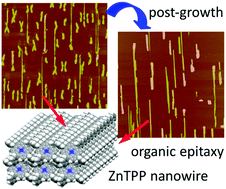Control of post-growth processes for the selection of metallo-tetraphenylporphyrin nanowires†
Abstract
Controlling self-organization of small organic molecules in nanostructures with a desired shape and size is one of the main challenges in organic nanoelectronics. Here, a strategy for selectively growing uniaxially aligned nanowires of meso-tetraphenyl porphyrin–Zn(II) (ZnTPP) is presented. ZnTPP is deposited on an organic single crystal, namely potassium hydrogen phthalate, by organic molecular beam epitaxy. The films typically display a rather rich surface morphology, characterized by the presence of nanowires and other nm-sized aggregates, most of them unstable over time. Post-growth processes occurring via quasi-Ostwald ripening both in air and in vacuum demonstrate an aging protocol in vacuum as a tool for the selection of ZnTPP nanowires, whose morphology and uniaxial orientation are demonstrated to be led by organic epitaxy. The ability of growing ZnTPP nanowires with a unique crystal structure and precise orientation gives the chance to observe the intrinsic optical anisotropy of the triclinic polymorph of ZnTPP crystal and establishes the role of intermolecular interactions, providing new perspectives in the study of the intrinsic physical properties of ZnTPP crystals.



 Please wait while we load your content...
Please wait while we load your content...